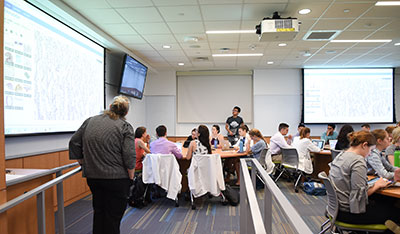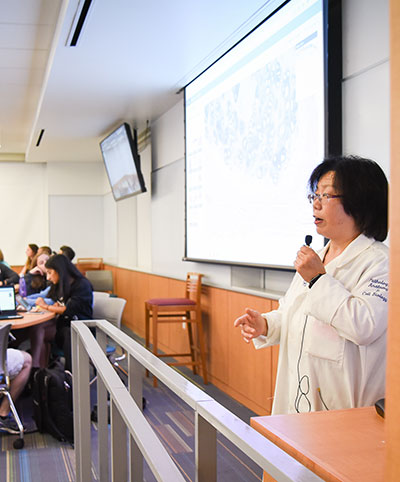A Healthy Upgrade: NEC Projectors and Displays Enhance Healthcare Sciences Learning at Philadelphia University
Classrooms look very different than they did a decade ago. Students and educators are reaping the benefits of collaboration that was not possible until recently. So when a university saw a way to enhance its medical sciences education spaces by making them more interactive and collaborative, it turned to technology. Read more about the challenge and solution in this case study.
| Quick Facts- The Challenge Expand and update a university's interactive healthcare education space.The Solution Seven NEC NP-PA653UL 6,500-lumen professional laser installation projectors with NEC NP41ZL zoom lenses with lens shift; three NEC NP-PA653UL 6,500-lumen professional laser installation projectors with three NEC NP40ZL zoom lenses with lens shift; and 10 NEC E655 65-inch LED backlit displays. The Result A larger, more open classroom with multiple audiovisual technologies that facilitate collaboration and immersive learning across the university's health sciences curriculum. |

Teaching, especially in higher education, has evolved dramatically since the rise of technology. Classrooms look very different than they did a decade or two ago, and students and educators alike are reaping the benefits of collaboration methods and visual aids that were not possible until recently.
So when a university in Philadelphia saw a way to enhance its healthcare and medical sciences education spaces by making them more interactive and collaborative, it turned to technology to make it happen.
The Challenge
Thomas Jefferson University (Jefferson) offers undergraduate and graduate programs in a multitude of disciplines, including medicine, nursing, health sciences, business, architecture, fashion, engineering, design and more.
A few years ago, the university's medical college overhauled its curriculum. To complement these changes, it also decided to experiment with interactive classrooms, including revamping two rooms with guitar pick-shaped tables at which nine students could sit in groups and view content from projectors and displays, as opposed to the traditional rows of seats facing screens and the instructor.
"The whole premise was to open up the teaching environment to make it an interactive effort between students and the instructor," said Rich Diperstein, account executive at New Era Technology, a full-service technology solutions provider. "There was no 'front' of the room."
While these rooms were intended to be used by the medical college and nursing school, they proved to be popular with other programs on campus as well. To accommodate this demand, the university wanted to create an even larger space with more seating capacity, and decided to transform an amphitheater-style room into a massive interactive classroom that could seat about 200 people.
This was an opportunity to not only create a better space, but also upgrade the classroom's technologies to the latest models, as well as employ the lessons learned from the previous spaces.
The Technology

Jefferson has been a client of Diperstein's for a decade and a half – during his tenure at New Era Technology as well as when he was at another integrator – and he has been working to homogenize the university's digital display and projector infrastructure.
"Throughout the years, we've partnered with the university to standardize to one manufacturer: NEC Display Solutions," he said.
"When we started working with Rich, he specified NEC as our manufacturer, and we've been keeping consistency of brand since," said Pejman Makarechi, biomedical communications director at Jefferson. "Everything in both traditional and interactive classrooms is pretty much NEC – including projectors and large monitors."
That made selecting a manufacturer for the upgraded interactive classrooms an easy choice – and for the technology itself, the university had even better options this time around.
"With the advent of the new laser phosphor projectors that had come onto the market between the first classroom and the second iteration, the university was able to get lower-maintenance, higher-resolution projectors, which was important to them," Diperstein said.
For the new classroom space, Diperstein specified seven NEC NP-PA653UL with NEC NP41ZL lenses; three NEC NP-PA653UL with three NEC NP40ZL lenses; and 10 NEC E655 65-inch displays, in addition to multiple other types of AV technology, including aMX video matrix and control systems, Shure microphones and Vaddio cameras.
With the technology selected, it was time to begin construction.
The Installation

Turning the auditorium into a large interactive classroom was a major construction project, requiring a full teardown of walls and concrete. One challenge during the construction and installation process, according to Diperstein, was the sheer size of the new space.
"It's double the space, and double the amount of technology, so it was critical to make sure everything worked and flowed properly within the space," he said. "From a display and audio perspective, because the second iteration was so large, sound reinforcement had to be really amped up so people could hear each other at a greater distance."
additional considerations involved the physical construction of the room. High ceilings – up to 22 feet in some places – were important in the 2.0 version of the interactive classroom. The ceilings in the other space were only about nine feet high, and students could raise their hands and touch the projector – not ideal for protecting the projectors from inadvertent damage.
Likewise, all mechanicals in the ceiling had to be removed so nothing would shake the projectors; the projection screens also had to be placed in a way that air from HVAC vents would not make the screens sway. Ambient light would interfere with the tracking cameras that followed the instructor around the room, so the room had to be equipped with blackout shades.
"Because this was a retrofit of an existing space, some structural elements in the building couldn't be moved, so we had to make sure all 180 students who would be in the room had a clear sightline to the monitors that show the instructors, and the projectors and screens that show the material," Makarechi said.
another part of the evolution from the first space to the second were better cameras to track the instructor around the room, and a smaller and more manageable "fob" (the way the camera tracks the instructor's movements) for the instructor to wear.
"We also added more intuitive ways to use web conferencing with the tracking camera, as well as table pop-ups with HDMI cables and a wireless collaboration system that allow students to present content either wired or wirelessly from their computers and devices," Diperstein said."The omnidirectional microphones installed at each table allow students to press a button and project their voices around the room, so we also implemented a better way to hand off audio in the room from table to table."
Makarechi noted another plus of updating the technology was the evolution of the projectors from the older laser models in the original rooms to the newest models.
"We used to have to use a vacuum to remove dust from the air filters, but the new models have much better ventilation to keep them cool, and negate the need to manually maintain them," he said. "They're smaller, quieter and deliver higher-resolution as well."
After the technology was specified in October 2017, construction of the new space ended in July 2018 and was ready for student and faculty use in August 2018.
The Results
Instructors use the new space to teach the medical college's curriculum across all body systems, such as the nervous system, pairing lectures with lab work and practicums. Other disciplines also can book the room.
The new, larger classroom is set up with (10) 1920 x 1200, 6,500-lumen NEC laser-hybrid projectors positioned on each of the four walls. The projectors and their accompanying ceilingrecessed screens are used to display the educational content.
Ten E655 65-inch HD NEC digital displays are adjacent to each projection screen and allow students to view the instructor via the ceiling-mounted auto-tracking camera. One screen is located on each of the two pillar walls at the front of the room. A ceiling-mounted camera and auto-tracking system tracks the instructor via infrared receiver. Instructors wear and/or carry the receiver, as well as a wireless lavalier or handheld microphone, as they lecture.
"Even though students sit at various angles around the room, the setup of the room means they don't need to be looking right at instructor to engage in or see the content," Diperstein said.
Every table where students sit has an omnidirectional microphone at the center, allowing students to present findings to the classroom at large by pressing a button and speaking into the mic.
"The idea is that the instructor does part of the teaching by lecturing for 20 or so minutes, and then the environment becomes group project-based, with the instructor walking around and answering questions before students present to the group," Makarechi said. "We've moved away from the traditional lecture-based classroom to an interactive one."
The room is fully driven by AMX video matrix and control processors, with instructors able to control everything in the room – including mics, lighting, window shades, volume, video cameras and more – via a 10-inch touch panel.
Makarechi said that instructors and students alike seem to appreciate the interactive, collaborative environment of the upgraded space.
"Just based on how often the instructors try to schedule their classes, it seems they like it – students, too," he said. "I think they're very happy with how the room is set up and how it works."
Diperstein added that the 2.0 version of the classroom is even more successful than the first version.
"The first one was so successful with this type of training module, and the reboot allowed us to build on the positives and adjust the negatives," he said. "Not a lot of colleges in this area are taking advantage of this type of learning environment, and the feedback I hear from anyone walking into the room is that it's a very impressive space to see."

